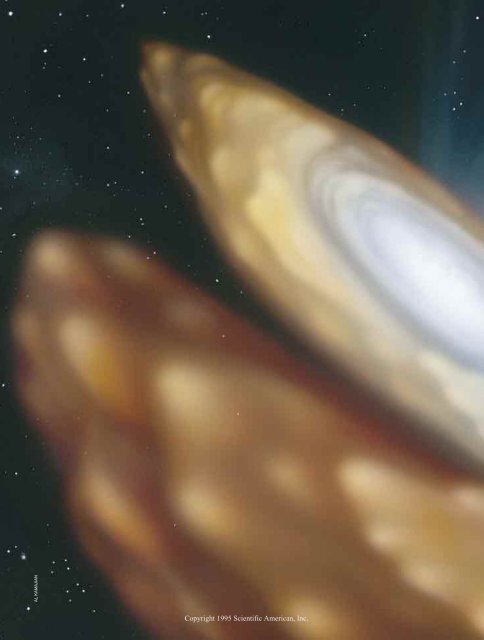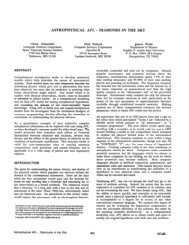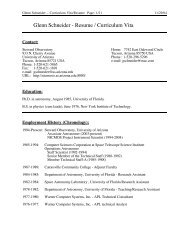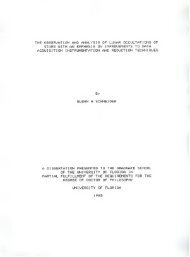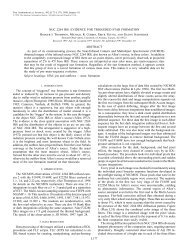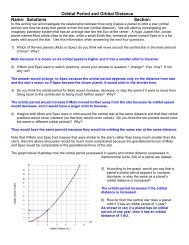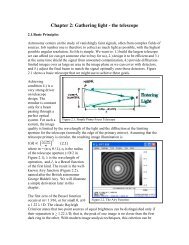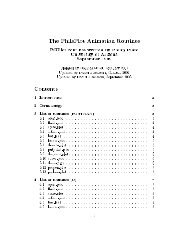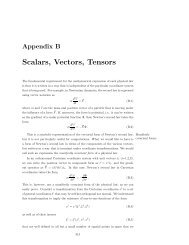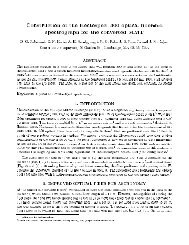Binary Neutron Stars - Scientific American Digital
Binary Neutron Stars - Scientific American Digital
Binary Neutron Stars - Scientific American Digital
Create successful ePaper yourself
Turn your PDF publications into a flip-book with our unique Google optimized e-Paper software.
AL KAMAJIAN<br />
Copyright 1995 <strong>Scientific</strong> <strong>American</strong>, Inc.
<strong>Binary</strong> <strong>Neutron</strong> <strong>Stars</strong><br />
These paired stellar remnants supply exquisite<br />
confirmations of general relativity. Their<br />
inevitable collapse produces what may<br />
be the strongest explosions<br />
in the universe<br />
by Tsvi Piran<br />
Copyright 1995 <strong>Scientific</strong> <strong>American</strong>, Inc.<br />
COLLIDING NEUTRON STARS<br />
mark the end of a pattern of stellar<br />
evolution that now appears to<br />
be more likely than astronomers<br />
once thought. More than half the<br />
stars in the sky belong to binary<br />
systems; perhaps one in 100 of<br />
the most massive pairs will ultimately<br />
become neutron star binaries.<br />
Gravitational waves given oÝ<br />
by the stars as they orbit each<br />
other carry away energy until the<br />
stars spiral together and coalesce.<br />
These mergers give oÝ radiation<br />
that may be detectable from billions<br />
of light-years away.
In 1967 Jocelyn Bell and Antony Hewish found the Þrst pulsar.<br />
Their radio telescope brought in signals from a source<br />
that emitted very regular pulses every 1.34 seconds. After<br />
eliminating terrestrial sources and provisionally discarding the<br />
notion that these signals might come from extraterrestrial intelligent<br />
beings, they were baÝled. It was Thomas Gold of Cornell<br />
University who realized that the pulses originated from a<br />
rotating neutron star, beaming radio waves into space like a<br />
lighthouse. Researchers soon tuned in other pulsars.<br />
Even as Bell and Hewish were making<br />
their discovery, military satellites orbiting<br />
the earth were detecting the signature<br />
of even more exotic signals: powerful<br />
gamma-ray bursts from outer space.<br />
The gamma rays triggered detectors intended<br />
to monitor illicit nuclear tests,<br />
but it was not until six years later that<br />
the observations were made public;<br />
even then, another 20 years passed before<br />
the burstsÕ origin was understood.<br />
Many people now think gamma-ray<br />
bursts are emitted by twin neutron stars<br />
in the throes of coalescence.<br />
The discovery of binary neutron stars<br />
fell to Russell A. Hulse and Joseph H.<br />
Taylor, Jr., then at the University of Massachusetts<br />
at Amherst, who began a<br />
systematic pulsar survey in 1974. They<br />
used the Arecibo radio telescope in<br />
Puerto Rico, the largest in the world,<br />
and within a few months had found 40<br />
previously unknown pulsars. Among<br />
their haul was a strange source named<br />
PSR 1913+16 (PSR denotes a pulsar,<br />
and the numbers stand for its position<br />
in the sky: 19 hours and 13 minutes<br />
longitude and a declination of 16 degrees).<br />
It emitted approximately 17<br />
pulses per second, but the period of<br />
the pulses changed by as much as 80<br />
microseconds from one day to the next.<br />
Pulsars are so regular that this small<br />
ßuctuation stood out clearly.<br />
Hulse and Taylor soon found that the<br />
timing of the signals varied in a regular<br />
pattern, repeating every seven hours<br />
and 45 minutes. This signature was not<br />
new; for many years astronomers have<br />
noted similar variations in the wavelength<br />
of light from binary stars (stars<br />
that are orbiting each other). The Doppler<br />
eÝect shortens the wavelength (and<br />
increases the frequency) of signals emitted<br />
when a source is moving toward the<br />
earth and increases wavelength (thus<br />
decreasing the frequency) when a source<br />
is moving away. Hulse and Taylor concluded<br />
that PSR 1913+16 was orbiting<br />
a companion star, even though available<br />
models of stellar evolution predicted<br />
only solitary pulsars.<br />
The surprises did not end there. Analysis<br />
of the time delay indicated that the<br />
pulsar and its companion were separated<br />
by a mere 1.8 million kilometers. At<br />
that distance, a normal star (with a radius<br />
of roughly 600,000 kilometers)<br />
would almost certainly have blocked the<br />
pulsarÕs signal at some point during its<br />
orbit. The companion could also not be<br />
a white dwarf (radius of about 3,000<br />
kilometers), because tidal interactions<br />
would have perturbed the orbit in a<br />
way that contradicted the observations.<br />
Hulse and Taylor concluded that the<br />
companion to PSR 1913+16 must be a<br />
neutron star.<br />
This Þnding earned the two a Nobel<br />
Prize in Physics in 1993. Astronomers<br />
have since mastered the challenge of<br />
understanding how binary neutron stars<br />
might exist at all, even as they have employed<br />
the signals these strange entities<br />
produce to conduct exceedingly Þne<br />
tests of astrophysical models and of<br />
general relativity.<br />
How a <strong>Binary</strong> <strong>Neutron</strong> Star Forms<br />
By all the astrophysical theories that<br />
existed before 1974, binary neutron<br />
stars should not have existed. Astronomers<br />
believed that the repeated stellar<br />
catastrophes needed to create them<br />
would disrupt any gravitational binding<br />
between two stars.<br />
<strong>Neutron</strong> stars are the remnants of<br />
massive stars, which perish in a supernova<br />
explosion after exhausting all their<br />
nuclear fuel. The death throes begin<br />
when a star of six solar masses or more<br />
consumes the hydrogen in its center,<br />
expands and becomes a red giant. At<br />
this stage, its core is already extremely<br />
dense: several solar masses within a radius<br />
of several thousand kilometers. An<br />
extended envelope more than 100 million<br />
kilometers across contains the rest<br />
of the mass. In the core, heavier elements<br />
such as silicon undergo nuclear<br />
fusion to become iron.<br />
When the core reaches a temperature<br />
of several billion kelvins, the iron nuclei<br />
begin to break apart, absorbing heat<br />
from their surroundings and reducing<br />
the pressure in the core drastically. Unable<br />
to support itself against its own<br />
gravitational attraction, the core collapses.<br />
As its radius decreases from several<br />
thousand kilometers to 15, electrons<br />
and protons fuse into neutrons, leaving<br />
a very dense star of 1.4 solar masses in<br />
a volume no larger than an asteroid.<br />
a<br />
b<br />
BINARY PAIR<br />
X-RAY BINARY<br />
54 SCIENTIFIC AMERICAN May 1995<br />
Copyright 1995 <strong>Scientific</strong> <strong>American</strong>, Inc.
c<br />
Meanwhile the energy released<br />
in the collapse heats<br />
the envelope of the star, which<br />
for a few weeks emits more<br />
light than an entire galaxy. Observations<br />
of old supernovae,<br />
such as the Crab NebulaÕs,<br />
whose light reached the earth<br />
in A.D. 1054, reveal a neutron<br />
star surrounded by a luminous<br />
cloud of gas, still moving<br />
out into interstellar space.<br />
More than half the stars in<br />
the sky belong to binary systems.<br />
As a result, it is not surprising<br />
that at least a few<br />
massive pairs should remain<br />
bound together even after one<br />
of them undergoes a supernova<br />
explosion. The pair then<br />
becomes a massive x-ray binary,<br />
so named for the emission<br />
that the neutron star<br />
produces as it strips the outer<br />
atmosphere from its companion.<br />
Eventually the second star<br />
also explodes as a supernova<br />
and turns into a neutron star.<br />
The envelope ejected by the<br />
second supernova contains<br />
most of the mass of the binary (since<br />
the remaining neutron star contains a<br />
mere 1.4 solar masses). The ejection of<br />
such a large fraction of the total mass<br />
should therefore disrupt the binary and<br />
send the two neutron stars (the old<br />
one and the one that has just formed)<br />
ßying into space with velocities of hundreds<br />
of kilometers per second.<br />
Hulse and TaylorÕs discovery demonstrated,<br />
however, that some binaries<br />
survive the second supernova explosion.<br />
In retrospect, astronomers realized that<br />
the second supernova explosion might<br />
be asymmetrical, propelling the newly<br />
formed neutron star into a stable orbit<br />
ORBITAL PRECESSION, the rotation of the major axis of an<br />
elliptical orbit, results from relativistic perturbations of<br />
the motion of fast-moving bodies in intense gravitational<br />
Þelds. It is usually almost undetectable; MercuryÕs orbit<br />
precesses by less than 0.12 of a degree every century, but<br />
that of PSR 1913+16 changes by 4.2 degrees a year.<br />
AL KAMAJIAN<br />
GEORGE RETSECK<br />
rather than out into the void. The second<br />
supernova also may be less disruptive<br />
if the second star loses its envelope<br />
gradually during the massive x-ray binary<br />
phase. Since then, the discovery of<br />
three other neutron star binaries shows<br />
that other massive pairs have survived<br />
the second supernova.<br />
Several years ago Ramesh Narayan of<br />
Harvard University, Amotz Shemi of Tel<br />
Aviv University and I, along with E. Sterl<br />
Phinney of the California Institute of<br />
Technology, working independently, estimated<br />
that about 1 percent of massive<br />
x-ray binaries survive to form neutron<br />
star binaries. This Þgure implies that<br />
our galaxy contains a population of<br />
about 30,000 neutron star binaries. Following<br />
a similar line of argument, we<br />
also concluded that there should be a<br />
comparable number of binaries, yet unobserved,<br />
containing a neutron star and<br />
a black hole. Such a pair would form<br />
when one of the stars in a massive pair<br />
formed a supernova remnant containing<br />
more than about two solar masses<br />
and so collapsed to a singularity instead<br />
of a neutron star. Rarer,<br />
but still possible in theory, are<br />
black hole binaries, which<br />
start their lives as a pair of<br />
particularly massive stars; they<br />
should number about 300 in<br />
our galaxy.<br />
Testing General Relativity<br />
PSR 1913+16 has implications<br />
that reach far beyond<br />
the revision of theories of binary<br />
stellar evolution. Hulse<br />
and Taylor immediately realized<br />
that their discovery had<br />
provided an ideal site for testing<br />
EinsteinÕs General Theory<br />
of Relativity.<br />
Although this theory is accepted<br />
today as the only viable<br />
description of gravity, it<br />
has had only a few direct tests.<br />
Albert Einstein himself computed<br />
the precession of MercuryÕs<br />
orbit (the shift of the<br />
orbital axes and the point of<br />
MercuryÕs closest approach to<br />
the sun) and showed that observations<br />
agreed with his theory.<br />
Arthur Eddington detected the<br />
bending of light rays during a solar<br />
eclipse in 1919. In 1960 Robert V.<br />
Pound and Glen A. Rebka, Jr., then both<br />
at Harvard, Þrst measured the gravitational<br />
redshift, the loss of energy by<br />
photons as they climb out of a powerful<br />
gravitational Þeld. Finally, in 1964,<br />
Irwin I. Shapiro, also at Harvard, pointed<br />
out that light signals bent by a gravitational<br />
Þeld should be delayed in comparison<br />
to those that take a straight<br />
path. He measured the delay by bouncing<br />
radar signals oÝ other planets in<br />
the solar system. Although general relativity<br />
passed these tests with ßying<br />
colors, they were all carried out in the<br />
(relativistically) weak gravitational Þeld<br />
of the solar system. That fact left open<br />
the possibility that general relativity<br />
might break down in stronger gravitational<br />
Þelds.<br />
Because a pulsar is eÝectively a clock<br />
orbiting in the strong gravitational Þeld<br />
of its companion, relativity makes a<br />
range of clear predictions about how<br />
the ticks of that clock (the pulses) will<br />
d<br />
MASSIVE BINARY (a) evolves through a sequence of violent events. The heavier<br />
star in the pair burns its fuel faster and undergoes a supernova explosion; if the<br />
two stars stay bound together, the result is a massive x-ray binary (b) in which the<br />
neutron star remnant of the Þrst star strips gas from its companion and emits x-radiation.<br />
Eventually the second star also exhausts its fuel. In roughly one of 100<br />
cases, the resulting explosion leaves a pair of neutron stars orbiting each other (c);<br />
in the other 99, the two drift apart (d). There are enough binary star systems that<br />
a typical galaxy contains thousands of neutron star binaries.<br />
Copyright 1995 <strong>Scientific</strong> <strong>American</strong>, Inc.<br />
SCIENTIFIC AMERICAN May 1995 55
FIRST-ORDER DOPPLER EFFECT<br />
a<br />
SECOND-ORDER DOPPLER EFFECT<br />
b<br />
OBSERVER<br />
OBSERVER<br />
GEORGE RETSECK<br />
BINARY PULSAR SIGNALS are aÝected by relativistic phenomena.<br />
(Each illustration above shows one of the eÝects<br />
whose combination produces the timing of the pulses that radio<br />
astronomers observe.) The Doppler eÝect slows the rate<br />
at which pulses reach an observer when the pulsar is moving<br />
away from the earth in its orbit and increases the rate when<br />
the pulsar is moving toward the earth (a). The second-order<br />
Doppler eÝect and the gravitational redshift (b) impose a sim-<br />
58 SCIENTIFIC AMERICAN May 1995<br />
appear from the earth. First, the Doppler<br />
eÝect causes a periodic variation in<br />
the pulsesÕ arrival time (the pattern that<br />
Þrst alerted Taylor and Hulse).<br />
A Òsecond-orderÓ Doppler eÝect, resulting<br />
from time dilation caused by the<br />
pulsarÕs rapid motion, leads to an additional<br />
(but much smaller) variation.<br />
This second-order eÝect can be distinguished<br />
because it depends on the<br />
square of velocity, which varies as the<br />
pulsar moves along its elliptical orbit.<br />
The second-order Doppler shift combines<br />
with the gravitational redshift, a<br />
slowing of the pulsarÕs clock when it is<br />
in the stronger gravitational Þeld closer<br />
to its companion.<br />
Like Mercury, PSR 1913+16 precesses<br />
in its orbit about its companion. The<br />
intense gravitational Þelds involved,<br />
however, mean that the periastronÑthe<br />
nadir of the orbitÑrotates by 4.2 degrees<br />
a year, compared with MercuryÕs<br />
perihelion shift of a mere 42 arc seconds<br />
a century. The measured eÝects<br />
match the predictions of relativistic<br />
theory precisely. Remarkably, the precession<br />
and other orbital information<br />
supplied by the timing of the radio<br />
pulses make it possible to calculate the<br />
masses of the pulsar and its companion:<br />
1.442 and 1.386 solar masses, respectively,<br />
with an uncertainty of 0.003<br />
solar mass. This precision is impressive<br />
for a pair of objects 15,000 lightyears<br />
away.<br />
In 1991 Alexander Wolszczan of the<br />
Arecibo observatory found another binary<br />
pulsar that is almost a twin to PSR<br />
1913+16. Each neutron star weighs between<br />
1.27 and 1.41 solar masses. The<br />
Shapiro time delay, which was only<br />
marginally measured in PSR 1913+16,<br />
stands out clearly in signals from the<br />
pulsar that Wolszczan discovered.<br />
Measurements of PSR 1913+16 have<br />
also revealed a relativistic eÝect never<br />
seen before. In 1918, several years after<br />
the publication of his General Theory of<br />
Relativity, Einstein predicted the existence<br />
of gravitational radiation, an analogue<br />
to electromagnetic radiation. When<br />
electrically charged particles such as<br />
electrons and protons accelerate, they<br />
emit electromagnetic waves. Analogously,<br />
massive particles that move with<br />
varying acceleration emit gravitational<br />
waves, small ripples in the gravitational<br />
Þeld that also propagate at the speed<br />
of light.<br />
These ripples exert forces on other<br />
masses; if two objects are free to move,<br />
the distance between them will vary<br />
with the frequency of the wave. The<br />
size of the oscillation depends on the<br />
separation of the two objects and the<br />
strength of the waves. In principle, all<br />
objects whose acceleration varies emit<br />
gravitational radiation. Most objects<br />
are so small and move so slowly, however,<br />
that their gravitational radiation<br />
is utterly insigniÞcant.<br />
<strong>Binary</strong> pulsars are one of the few exceptions.<br />
The emission of gravitational<br />
waves produces a detectable eÝect on<br />
the binary system. In 1941, long before<br />
the discovery of the binary pulsar, the<br />
Russian physicists Lev D. Landau and<br />
Evgenii M. Lifshitz calculated the eÝect<br />
of this emission on the motion of a binary.<br />
Energy conservation requires that<br />
the energy carried away by the waves<br />
come from somewhere, in this case the<br />
orbital energy of the two stars. As a result,<br />
the distance between them must<br />
decrease.<br />
PSR 1913+16 emits gravitational radiation<br />
at a rate of eight quadrillion gigawatts,<br />
about a Þfth as much energy<br />
as the total radiation output of the sun.<br />
This luminosity is impressive as far as<br />
gravitational radiation sources are concerned<br />
but still too weak to be detected<br />
directly on the earth. Nevertheless, it<br />
has a noticeable eÝect on the pulsarÕs<br />
orbit. The distance between the two<br />
neutron stars decreases by a few meters<br />
a year, which suÛces to produce a detectable<br />
variation in the timing of the<br />
radio pulses. By carefully monitoring<br />
the pulses from PSR 1913+16 over the<br />
years, Taylor and his collaborators have<br />
shown that the orbital separation decreases<br />
in exact agreement with the<br />
predictions of the General Theory of<br />
Relativity.<br />
The reduction in the distance between<br />
the stars can be compared with the other<br />
general relativistic eÝects to arrive<br />
at a further conÞrmation. Just as measurements<br />
of the orbital decay produce<br />
a mathematical function relating the<br />
mass of the pulsar to the mass of its<br />
companion, so do the periastron shift<br />
Copyright 1995 <strong>Scientific</strong> <strong>American</strong>, Inc.
SHAPIRO TIME DELAY<br />
c<br />
d<br />
OBSERVER<br />
OBSERVER<br />
ilar variation because the pulsarÕs internal clock slows when<br />
it moves more rapidly in its orbit closest to its companion<br />
(shown by longer arrow). Most subtle is the so-called Shapiro<br />
time delay, which occurs as the gravitational Þeld of the pulsarÕs<br />
companion bends signals passing near it (c). The signals<br />
travel farther than they would if they took a straight-line path<br />
(d ) and so arrive later. This eÝect is undetectable in PSR<br />
1913+16 but shows up clearly in a more recent discovery.<br />
and the second-order Doppler eÝect.<br />
All three functions intersect at precisely<br />
the same point.<br />
Undetectable Cataclysms<br />
At present, the distance between PSR<br />
1913+16 and its companion is decreasing<br />
only slowly. As the distance between<br />
the stars shrinks, the gravitational<br />
wave emission will increase, and the<br />
orbital decay will accelerate. Eventually<br />
the neutron stars will fall toward each<br />
other at a signiÞcant fraction of the<br />
speed of light, collide and merge. The<br />
300 million years until PSR 1913+16<br />
coalesces with its companion are long<br />
on a human scale but rather short on<br />
an astronomical one.<br />
Given the number of neutron star binaries<br />
in the galaxy, one pair should<br />
merge roughly every 300,000 years, a<br />
cosmological blink of the eye. Extrapolating<br />
this rate to other galaxies implies<br />
that throughout the observable universe<br />
about one neutron star merger occurs<br />
every 20 minutesÑfrequently enough<br />
that astronomers should consider<br />
whether they can detect such collisions.<br />
To Þgure out whether such occurrences<br />
are detectable requires a solid<br />
understanding of just what happens<br />
when two orbiting neutron stars collide.<br />
Shortly after the discovery of the Þrst<br />
binary pulsar, Paul Clark and Douglas<br />
M. Eardley, then both at Yale University,<br />
concluded that the Þnal outcome is<br />
a black hole. Current estimates of the<br />
Copyright 1995 <strong>Scientific</strong> <strong>American</strong>, Inc.<br />
GRAVITY-WAVE AMPLITUDE<br />
TIME BEFORE IMPACT<br />
maximum mass of a neutron star range<br />
between 1.4 and 2.0 solar masses. Rotation<br />
increases the maximal mass, but<br />
most models suggest that even a rapidly<br />
rotating neutron star cannot be signiÞcantly<br />
larger than 2.4 solar masses.<br />
Because the two stars together contain<br />
about 2.8 solar masses, collapse to a<br />
singularity is almost inevitable.<br />
Melvyn B. Davies of Caltech, Willy<br />
Benz of the University of Arizona, Freidrich<br />
K. Thielemann of the Harvard-<br />
Smithsonian Center for Astrophysics<br />
and I have simulated the last moments<br />
of a neutron star binary in detail. The<br />
two objects are very dense and so behave<br />
eÝectively like point masses until<br />
they are quite close to each other. Tidal<br />
interaction between the stars becomes<br />
important only when they approach to<br />
within 30 kilometers, about twice the<br />
radius of a neutron star. At that stage,<br />
they begin to tear material from each<br />
otherÑabout two tenths of a solar mass<br />
in total. Once the neutron stars touch,<br />
within a tiny fraction of a second they<br />
coalesce. The matter torn from the<br />
stars before the collision forms a disk<br />
around the central core and eventually<br />
spirals back into it.<br />
What kinds of signals will this sequence<br />
of events generate? Clark and<br />
GRAVITY WAVES from coalescing neutrons stars have a distinctive signature. As<br />
the two stars spiral together during the last minutes of their lives, they emit gravitational<br />
radiation whose frequency is related to their orbital period. The signal increases<br />
in amplitude and ÒchirpsÓ from a few cycles to several hundred cycles per second.<br />
SCIENTIFIC AMERICAN May 1995 59<br />
LAURIE GRACE
Eardley realized that the colliding stars<br />
will warm up and reach temperatures<br />
of several billion kelvins. They Þgured<br />
that most of the thermal energy would<br />
be radiated as neutrinos and antineutrinos,<br />
much as it is in a supernova. Unfortunately,<br />
these weakly interacting,<br />
massless particles, which escape from<br />
the dense neutron star much more easily<br />
than do photons, are almost undetectable.<br />
When supernova 1987A exploded,<br />
the three detectors on the<br />
earth caught a total of 21 neutrinos out<br />
of the 5 × 10 46 joules of radiation. Although<br />
the burst expected from a binary<br />
neutron star merger is slightly larger<br />
than that of a supernova, the typical<br />
event takes place much farther away<br />
than the mere 150,000 light-years of<br />
SN 1987A. To detect one merger a year<br />
would require picking up signals one<br />
sixteen-millionth the intensity of the<br />
1987 event. Because current neutrino<br />
detectors must monitor interactions<br />
within thousands of tons of material, it<br />
is diÛcult to imagine the apparatus that<br />
would be required. Furthermore, supernovae<br />
are 1,000 times more frequent<br />
than are neutron star collisions. Even if<br />
we detected a neutrino burst from two<br />
neutron stars, it is unlikely we would<br />
be able to distinguish it among the far<br />
more numerous and far more intense<br />
supernova neutrino bursts.<br />
Before it emits its neutrino burst, the<br />
neutron star binary sends out a similarly<br />
energetic (but not quite so undetectable)<br />
train of gravitational waves. During<br />
the 15 minutes before coalescence,<br />
the two stars cover the last 700 kilometers<br />
between them, and their orbital period<br />
shrinks from a Þfth of a second to<br />
a few milliseconds. The resulting signal<br />
is just in the optimal range for terrestrial<br />
gravity-wave detectors.<br />
An international network of such detectors<br />
is now being built in the U.S. and<br />
in Italy. The <strong>American</strong> Caltech-M.I.T.<br />
team is building detectors for the Laser<br />
Interferometer Gravitational-Wave Observatory<br />
(LIGO) near Hanford in Washington<br />
State and near Livingston in Louisiana.<br />
The French-Italian team is constructing<br />
its VIRGO facility near Pisa in<br />
Italy. The Þrst detectors should be able<br />
to detect neutron star mergers up to<br />
70 million light-years away; current estimates<br />
suggest that there is only one<br />
event per 100 years up to this distance.<br />
Researchers have proposed to improve<br />
their instruments dramatically over the<br />
subsequent few years; eventually they<br />
should be able to detect neutron star<br />
mergers as far away as three billion<br />
light-yearsÑseveral hundred a year.<br />
High-Energy Photons<br />
For several years after the discovery<br />
of PSR 1913+16, I kept wondering<br />
whether there was a way to estimate<br />
what fraction of the coalescing starsÕ<br />
binding energy is emitted as electromagnetic<br />
radiation. Even if this fraction<br />
is tiny, the binding energy is so large<br />
that the resulting radiation would still<br />
be enormous. Furthermore, photons are<br />
much easier to detect than neutrinos<br />
or gravitational waves, and so mergers<br />
could be detected even from the most<br />
distant parts of the universe.<br />
In 1987 J. Jeremy Goodman of Princeton<br />
University, Arnon Dar of the Technion<br />
and Shmuel Nussinov of Tel Aviv<br />
University noticed that about a tenth of<br />
a percent of the neutrinos and antineutrinos<br />
emitted by a collapsing supernova<br />
core collide with one other and annihilate<br />
to produce electron-positron pairs<br />
and gamma rays. In a supernova the<br />
absorption of these gamma rays by the<br />
starÕs envelope plays an important role<br />
in the explosion of the outer layers.<br />
In 1989 David Eichler of Ben Gurion<br />
University of the Negev, Mario Livio of<br />
the Technion, David N. Schramm of the<br />
University of Chicago and I speculated<br />
that a similar fraction of the neutrinos<br />
released in a binary neutron star merger<br />
would also produce electron-positron<br />
pairs and gamma rays. The colliding<br />
neutron stars, however, have no envelope<br />
surrounding them, and so the gamma<br />
rays escape in a short, intense burst.<br />
Gamma-ray bursts might arise from<br />
a more complex mechanism. The disk<br />
that forms during the neutron star<br />
merger falls back onto the central coalesced<br />
object within a few seconds, but<br />
during that time it, too, can trigger<br />
emissions. In 1992 Bohdan Paczynski «<br />
of Princeton, Narayan of Harvard and I<br />
suggested that the rotation of the disk<br />
could intensify the neutron-star magnetic<br />
Þelds entangled in the diskÕs material,<br />
causing giant magnetic ßares, a<br />
scaled-up version of the ßares that rise<br />
from the surface of the sun. These<br />
short-lived magnetic disturbances could<br />
generate gamma-ray bursts in the same<br />
way that solar ßares produce gamma<br />
rays and x-rays. The large variability in<br />
the observed bursts implies that both<br />
mechanisms may be at work.<br />
BURST<br />
MAGNETIC-<br />
FIELD<br />
LINES<br />
GAMMA-RAY BURSTS may also result from a mechanism similar to the one that<br />
powers solar ßares. The magnetic Þeld from the coalesced neutron stars is ampli-<br />
Þed as it winds through the disk of material thrown out during the merger. The Þeld<br />
accelerates charged particles until they emit gamma rays.<br />
GEORGE RETSECK<br />
A Puzzle Unscrambled<br />
Had it not been for the Limited Test<br />
Ban Treaty of 1963, we would not<br />
have known about these bursts until<br />
well into the next century. No one would<br />
have proposed a satellite to look for<br />
them, and had such a proposal been<br />
made it would surely have been turned<br />
down as too speculative. But the U.S.<br />
Department of Defense launched a series<br />
of satellites known as Vela, which<br />
carried omnidirectional x-ray and gamma-ray<br />
detectors to verify that no one<br />
was testing nuclear warheads in space.<br />
These spacecraft never detected a nuclear<br />
explosion, but as soon as the Þrst<br />
satellite was launched it began to detect<br />
entirely unexpected bursts of highenergy<br />
photons in the range of several<br />
hundred kiloelectron volts. Bursts lasted<br />
between a few dozen milliseconds<br />
and about 30 seconds. The lag between<br />
the arrival time of the bursts to diÝerent<br />
satellites indicated that the sources<br />
60 SCIENTIFIC AMERICAN May 1995<br />
Copyright 1995 <strong>Scientific</strong> <strong>American</strong>, Inc.
were outside the solar system.<br />
Still, the bursts were<br />
kept secret for several<br />
years, until in 1973 Ray W.<br />
Klebesadel, Ian B. Strong<br />
and Roy A. Olson of Los<br />
Alamos National Laboratory<br />
described them in a<br />
seminal paper. Theorists<br />
proposed more than 100<br />
models in the next 20<br />
years; in the late 1980s a<br />
consensus formed that<br />
the bursts originated on<br />
neutron stars in our own<br />
galaxy.<br />
A minority led by Paczynski<br />
« argued that the<br />
bursts originated at cosmological<br />
distances. In<br />
the spring of 1991 the<br />
Compton Gamma Ray Observatory,<br />
which was more<br />
sensitive than any previous<br />
gamma-ray satellite,<br />
was launched by the National<br />
Aeronautics and<br />
Space Administration. It<br />
revealed two unexpected<br />
facts. First, the distribution<br />
of burst intensities is<br />
not homogeneous in the<br />
way that it would be if the<br />
bursts were nearby. Second,<br />
the bursts came from<br />
all across the sky rather<br />
than being concentrated<br />
in the plane of the Milky<br />
Way, as they would be if<br />
they originated in the galactic disk. Together<br />
these facts demonstrate that the<br />
bursts do not originate from the disk<br />
of our galaxy. A lively debate still prevails<br />
over the possibility that the bursts<br />
might originate from the distant parts<br />
of the invisible halo of our galaxy, but<br />
as the Compton Observatory collects<br />
more data, this hypothesis seems less<br />
and less likely. It seems that the minority<br />
was right.<br />
In the fall of 1991, I analyzed the distribution<br />
of burst intensities, as did Paczynski<br />
« and his colleague Shude Mao.<br />
We concluded that the most distant<br />
JOHN LONG<br />
LIGO INTERFEROMETERS, one of which is shown here under construction,<br />
should one day be able to detect the gravitational radiation<br />
of colliding neutron stars from a distance of billions of lightyears.<br />
If these signals arrive at the same time as gamma-ray bursts,<br />
a decades-old mystery may be solved.<br />
bursts seen by the Compton Observatory<br />
came from several billion light-years<br />
away. Signals from such distances are<br />
redshifted (their wavelength is increased<br />
and energy decreased) by the<br />
expansion of the universe. As a result,<br />
we predicted that the cosmological redshift<br />
should lead to a correlation between<br />
the intensity of the bursts, their<br />
duration and their spectra. Fainter<br />
bursts, which tend to come from farther<br />
away, should last longer and contain<br />
a lower-energy distribution of gamma<br />
rays.<br />
Recently a NASA team headed by Jay<br />
P. Norris of the Goddard<br />
Space Flight Center has<br />
found precisely such a<br />
correlation. The number<br />
of bursts that the Compton<br />
Observatory records<br />
also tallies quite well with<br />
our earlier estimates of the<br />
binary neutron star population.<br />
Roughly 30,000<br />
mergers should occur every<br />
year throughout the<br />
observable universe, and<br />
the satelliteÕs detectors can<br />
scan a sphere containing<br />
about 3 percent of that<br />
volume. Our rough estimates<br />
suggest 900 mergers<br />
a year in such a space;<br />
the Compton Observatory<br />
notes 1,000 bursts.<br />
Although the details of<br />
how colliding neutron<br />
stars give rise to gamma<br />
rays are still being worked<br />
out, the tantalizing agreement<br />
between these data<br />
from disparate sources<br />
implies that astronomers<br />
have been detecting neutron<br />
star mergers without<br />
knowing it for the past 25<br />
years. Researchers have<br />
proposed a few other<br />
sources that might be capable<br />
of emitting the enormous<br />
amounts of energy<br />
needed for cosmological<br />
gamma-ray bursts. The<br />
merger model, however, is the only one<br />
based on an independently observed<br />
phenomenon, the spiraling in of a neutron<br />
star binary as a result of the emission<br />
of gravity waves.<br />
It is the only model that makes a<br />
clear prediction that can be either con-<br />
Þrmed or refuted. If, as I expect, LIGO<br />
and VIRGO detect the unique gravitational-wave<br />
signal of spiraling neutron<br />
stars in coincidence with a gamma-ray<br />
burst, astrophysicists will have opened<br />
a new window on the Þnal stages of<br />
stellar evolution, one that no visiblelight<br />
instruments can hope to match.<br />
About the Author<br />
TSVI PIRAN has studied general relativity<br />
and astrophysics for 20 years. He is a<br />
professor at the Hebrew University of<br />
Jerusalem, where he received his Ph.D. in<br />
1976. He has also worked at the University<br />
of Oxford, Harvard University, Kyoto<br />
University and Fermilab. Piran, with<br />
Steven Weinberg of the University of<br />
Texas, established the Jerusalem Winter<br />
School for Theoretical Physics.<br />
Further Reading<br />
BLACK HOLES, WHITE DWARFS AND NEUTRON STARS: THE PHYSICS OF COMPACT OBJECTS. Stuart<br />
L. Shapiro and Saul A. Teukolsky. Wiley Interscience, 1983.<br />
WAS EINSTEIN RIGHT? PUTTING GENERAL RELATIVITY TO THE TEST. CliÝord M. Will. Basic<br />
Books, 1988.<br />
LIGO: THE LASER INTERFEROMETER GRAVITATIONAL-WAVE OBSERVATORY. Alex Abramovici et<br />
al. in Science, Vol. 256, pages 325Ð333; April 17, 1992.<br />
PROBING THE GAMMA-RAY SKY. Kevin Hurley in Sky and Telescope, Vol. 84, No. 6, pages<br />
631Ð636; December 1992.<br />
X-RAY BINARIES. Edward P. J. van den Heuvel and Jan van Paradijs in ScientiÞc <strong>American</strong>, Vol.<br />
269, No. 5, pages 64Ð71; November 1993.<br />
Copyright 1995 <strong>Scientific</strong> <strong>American</strong>, Inc.<br />
SCIENTIFIC AMERICAN May 1995 61


